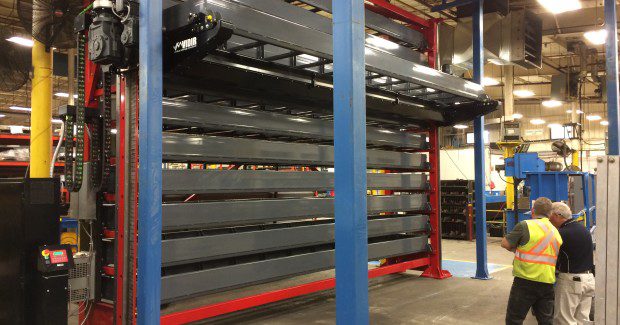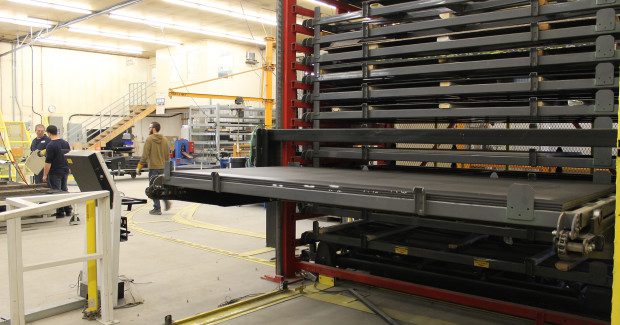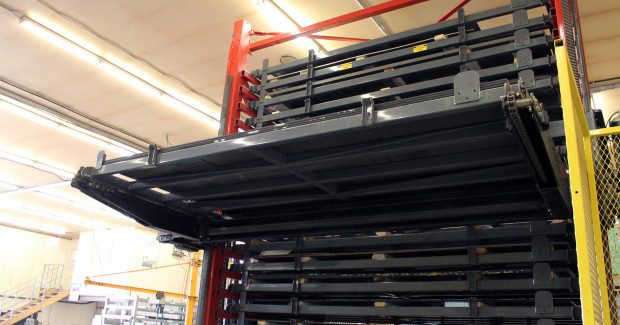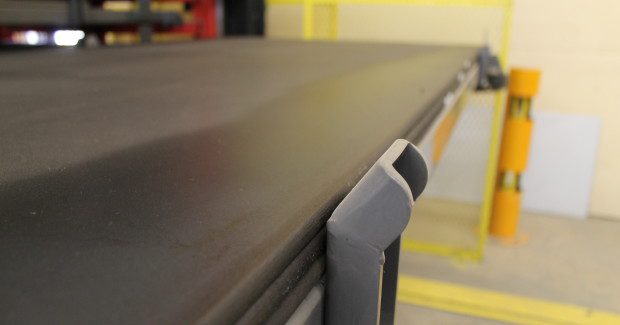Up for Grabs
Guest columnist Dean Dueck of Vidir explains how the rack and pinion drives, simplified controls architecture and ergonomic loading/unloading design of the latest generation of automated vertical lifts for sheet metal storage enable smaller shops to improve safety and minimize downtime.
Posted: September 3, 2015
The growing movement toward smaller order sizes and just-in-time delivery places very high demands on all aspects of sheet metal fabrication. Mechanical, hydraulic and pneumatic presses used in metalworking have improved automation and drive engineering for extremely fast response times, with critical press safety functions being executed through integrated controls that protect both operators and machines, a welcome addition when running 500 ton or 1,000 ton presses.
But not all aspects of sheet metal fabrication are quite so automated. Consider the storage and supply of sheet metal to the machine tools. Although most high-volume metalworking shops utilize highly automated and usually complex lift systems for storing sheet metal and releasing it into production, the majority of medium-to-smaller volume shops still manage the handling of sheets with fixed racking and forklifts. Such manual storage and material handling procedures not only consume large areas of valuable production space and are highly labor intensive, but they also frequently require interruption of adjacent production areas, which slows shop throughput and heightens the probability for workplace accidents.
One area of critical focus in the handling of sheet metal is forklift safety. The Industrial Truck Association (Washington, DC) states that over 11 percent of all forklifts are involved in some type of accident each year. OSHA statistics indicate that there are approximately 85 forklift fatalities annually in the United States, plus an additional 34,900 serious forklift injuries and 61,800 forklift injuries classified as non-serious each year. According to OSHA, 42 percent of forklift fatalities occur in manufacturing and almost half of those deaths are caused by the forklift tipping because of unstable loads. To reduce the possibility of this happening, OSHA recommends keeping the forklift load as low as possible, but this is simply not feasible when forklifts must manipulate 5 ft x 10 ft sheets of sheet metal from stationary storage locations 14 ft above the floor.
Now a new generation of automated sheet metal vertical lifts can enable low-to-medium volume sheet metal shops to easily access automated storage within their production areas. Different from vertical lifts that are used to service high-volume production areas, these new fully automated systems are designed for smaller sheet metal volumes. But like the bigger systems, these machines can also be adapted for the storage of sheet metal, bar stock, press brake dies and punches, and other materials. Designed to feed processing centers, and specifically flat sheet laser cutting systems directly, this sheet metal lift creates a storage center capable of continuously feeding production machines to minimize downtime and increase operational efficiency in the smaller shop.
The system can be configured between 10 ft and 24 ft tall with up to 38 shelf storage positions for storage with pallets or without, each capable of supporting 5,000 lb. Instead of a forklift suspending a 5,000 lb pallet of sheet metal or a 3,000 lb press die a dozen feet above the work area, the system’s rack and pinion driven elevator travels vertically to bring the desired shelf that supports the material down to an ergonomically comfortable position for the operator to access. The rack and pinion drive provides more positive movement, better stability and less servicing compared to chain or belt driven designs. Once the sheet metal, roll bar or die is accessed by the operator, it can then be transported to the machine tool via suction device or carried by forklift at a low, relatively safe height. These new-generation lifts greatly remove the forklift from the equation.
This type of lift storage system is a base-level machine that is not intended for a large metalworking facility that integrates storage modules in different locations throughout the shop floor. It has been developed so that smaller shops could load materials at a safe height and let the machine do the put-away. By incorporating a single rack with 20 to 30 storage locations, it can serve as a supply point to several presses or laser cutting systems. This sheet metal lift is equipped with PLC driven automation, a touch screen HMI that enables precise control of the shelves, and inventory control software. Its safety system is designed to SIL 3/CAT 4 and features access restriction fencing around the perimeter, with light curtains to prevent access during operation.
This new generation of automated sheet metal storage systems increase workplace safety and product security by providing a secure and controlled delivery method for heavy pallets of sheet metal stored overhead. By investing in vertical storage, smaller shops can reduce their storage footprint by combining multiple sheet metal racks into a single tower that feeds processing machines directly. The added accessibility, increased storage and improved material flow can increase efficiency for a tangible ROI. These compact sheet metal lifts are ideal for the small and mid-sized sheet metal shop that does not need a large modular and integrated system or have the capital to invest in such a lift. Aside from improved safety, many smaller shops realize a 50 percent to 75 percent reduction in cycle time when supplying sheet metal to their machine tools.
No longer do sections of the shop have to temporarily shut down so that forklifts can manipulate large loads suspended near their work areas. No longer do workers have to be pulled off their production assignments to spot these forklift loads and impact shop labor costs. No longer do smaller shops have to absorb the costs of facility, material and product damage from forklift usage. All of these tangible benefits can be realized by any fabrication shop that employs automated sheet metal lifts. Shorter runs and just-in-time ordering demand more frequent changeovers, which means more frequent access to metal storage locations, and more frequent maneuvering of suspended loads with forklifts. These factors are driving smaller sheet metal shops to rethink their operations and reevaluate the automation of their sheet metal storage and handling.
Patrick Roberts, a reporter on the advances in material handling technology, wrote this column.















